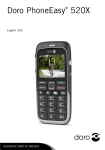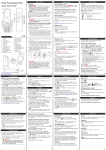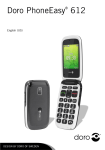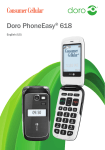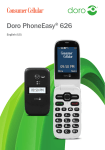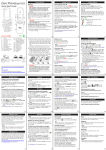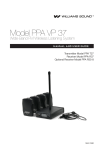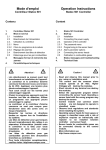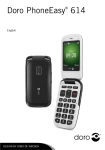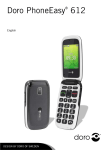Download Doro 520 User guide
Transcript
Getting Started Doro PhoneEasy 520X ® Charging Quick Start Guide 2 WARNING Only use batteries, charger and accessories that have been approved for use with this particular model. Connecting other accessories may be dangerous and may invalidate the phone’s type approval and guarantee. 16 15 1 14 3 18 13 12 11 4 5 6 10 7 9 Important! Turn off the phone and disconnect the charger before removing the battery cover. 22 The SIM card and battery are normally preinstalled for you. Follow these instructions should you ever need to access them yourself. 2 1 1. 2. 3. 4. 5. 6. 7. 8. 9. 10. 11. 12. 13. Volume control Headset socket Left selection button Call button Speed dial Voice mail Key lock Microphone Silent/Input method Camera shortcut SMS shortcut End call/Power on/off Arrow buttons 14. 15. 16. 17. 18. 19. 20. 21. 22. 23. 24. 25. 3 4 1.Remove the battery cover and the battery if it Right selection button Earpiece Torch Torch button Charging socket Camera lens Camera flash Assistance button Loudspeaker Battery cover/lock Lanyard Charging stand is already installed. Unlock the battery cover by turning the screw a quarter of a turn counter clockwise. 2.Optional: Insert the memory card into the slot under the SIM card holder. Make sure that the memory card contacts are facing inwards and push the card in, until you hear a click. Take care not to scratch or bend the contacts on the card. To remove or replace the card, push the card in until you hear a click and then pull the card out. 3.Insert the SIM card by gently sliding it into the holder. Make sure that the SIM card’s contacts are facing inwards and that the cut off corner is pointing downwards. Take care not to scratch or bend the contacts on the SIM card. 4.Insert the battery by sliding it into the battery compartment with the contacts facing upwards to the left. Replace the battery cover and lock it by turning the screw a quarter of a turn clockwise. 24 Call log Press and hold the red button on the phone to turn it on/off. It takes several seconds so keep holding until you hear the sound. Received, missed, and dialled calls are saved in a combined call log. 20 calls of each type can be stored in the log. For multiple calls related to the same number, only the most recent call is saved. Retrieving and dialling 1.Press . 2.Use / to scroll through the call log The default language is determined by the SIM card. See the full manual on how to change language, time and date. When starting the telephone for the first time, you can use the Start-up wizard to set some basic settings. Making a call 1.Enter the phone number. 2.Press to start the call. 3.Press to end the call. Using Phonebook Receiving a call 1.Press to answer, or press Silent to switch off the ring signal and then Reject to reject the call (busy signal). Alternately, press to reject the call directly. 2.Press to end the call. Volume control Using Phonebook The selection buttons have multiple functions. The current button function is shown above the selection button on the display. phonebook, or quick search by pressing the key corresponding to the first letter of the entry. 3.Press Call to dial the highlighted entry, or press Back. Creating ICE entry (In Case of Emergency) First responders can access additional information such as medical information from the victim’s phone in case of emergency. In the event of a trauma, it is critical to have this information as early as possible to increase the chances of survival. All fields are optional, but the more information provided the better. 1.Press Menu, scroll to and press OK. 2.Select and press OK, then use to scroll the list of entries. 3.Press Edit to add or edit information in each entry. Delete with Clear. Press Save when done. See Phonebook/ICE in the full manual. 3. / SOS/911 Calls and press OK. or press Menu, scroll to any selection the picture is saved). Messages Creating and sending text messages/SMS or press Menu, scroll to and press OK. 2.Select Create new and press OK. 3.Select SMS and press OK. 4.Type your message, then press To. 5.Select a recipient from Phonebook and press OK. Alternatively, select Enter number and press OK to add recipient manually and press Done. 6.Select Add to add more recipients or select Send to send and then press OK. 7.You can also modify the recipients by selecting one and press Options to Edit, Delete or Delete all. Note! If you choose to add multiple recipients, you will be charged for each recipient (maximum 10). Note! Sometimes an emergency call cannot be placed due to network, environment or interference issues. Creating and sending picture messages/MMS A MMS message can contain text and media objects such as pictures, sound recordings and video. Both you and the recipient must have subscriptions that support MMS. The numerical buttons A–B and the numerical keys 0 and 2–9 can be used for speed dialing. Entering text with predictive text Top 10 The Assistance button allows easy access to contact your predefined help numbers (Number list) should you need help. The Assistance function must be activated before use. See Assistance in the full manual. CAUTION When an emergency call is activated the phone is pre-set to handsfree mode. Do not hold the device near your ear when the handsfree mode is in use, because the volume may be extremely loud. Speed dial Adding speed dial numbers Menu Settings Calls Speed dial. In some languages you can use Smart ABC (eZiType™) input method which uses a dictionary to suggest words. See Settings/Messages/ Predictive text in the full manual. Set the entry as one of the first 10 contacts listed in the phonebook. Menu Settings Calls Top 10. Entering phone numbers Bluetooth® For international calls, always use + before the country code for best operation. Press * twice for the international prefix +. You can dial or save phone numbers with pauses for use with automated systems, such as voicemail or credit card billing numbers. There are two types of pauses available on your phone, press * repeatedly until desired character is shown. You can connect wireless to other Bluetooth compatible devices such as headsets. Menu Settings Bluetooth OK. Useful Tools Silent mode Alarm Use Silent to silence your ring tones. Use the Alarm feature to set wake-up call or help you keep track of an important time. Press and hold # to activate/deactivate Silent. Menu Alarm. Tip: Press and hold + or – to temporary switch off the ring signal without opening the flip. Organizer Use the Organizer to store tasks to help you keep track of important events. Changing Ringtones You can select different ring tones. Follow this sequence to reach the customization. 1.Press Menu, scroll to and press OK. 2.Select Create new and press OK. 3.Select MMS and press OK. 4.Type your message, then press Options. 5.Select Add picture to add items to your Assistance Button The voice mailbox can be called by pressing and holding 1. Custom Settings When you receive a message while your phone is on, the screen will display . Press Read to read the message. Most networks accept calls to emergency numbers without a valid SIM card. Contact your service provider for more information. Voice mail Press * for a list of special characters. Select the desired character with / and press OK to enter it. Use the side keys +/– or / to move the cursor within the text. Press # to cycle upper case, lower case and numerals. Reading an incoming message As long as the phone is switched on, it is always possible to place an SOS call by entering the main local emergency number for your present location followed by . Menu Organizer. Menu Settings Sound Tone setup Ringtone. message, or select Add subject to enter subject. 6.Add recipients with To and Send when ready. Use / to scroll between options. When you pause on a melody, you will hear its sound. Once you have found the ringtone you wish to use, press OK to select. See Messages in the full manual. Note! These functions will work even when the phone is switched off. Calculator The Calculator can perform basic math operations. You can use this same process to customize the tones for the Alarm, Message tone, Keypad tone, Power on and Power off in the same way. A voice message use the same technology as a picture message. 4. Other Call Options Press a numerical key repeatedly until desired character is shown. Wait a few seconds before entering the next character. 2.Press to take photo. 3.Press Options or Back (if you do not make 1.Press shortcut Menu Phonebook scroll to desired entry Options Delete OK. Press Yes to confirm or No to cancel. Entering Text To get sharp photos, wipe the lens clean with a dry cloth. 1.Press shortcut 1.Press Menu, scroll to and press OK. 2.Select -New contact- and press Add. 3.Enter a Name for the contact, see Entering Deleting entries in Phonebook Camera Making a call from the Phonebook 1.Press Name to open the phonebook. 2.Use / to scroll through the Creating a phonebook entry text in the full manual. Delete with Clear. / to select Mobile, Home or Office, enter the phone number(s) including the area code. 5.Select Picture and press Edit to associate a picture to the contact. This picture will be displayed when the correspondning contact is calling you and may also be visible in the phonebook. Select Take picture and press OK for using the camera to take a picture. Select My pictures and press OK to select an existing picture. 6.Press Save. 7.Press to return to standby. See Phonebook picture in the full manual. Selection buttons 2. 1. The Phonebook can store 300 entries with 3 phone numbers in each entry. 4.Use Use the side buttons +/– to adjust the sound volume. The volume level is indicated on the display. When a call is in progress, the volume control adjusts the earpiece volume. When the phone is ringing, the volume control adjusts the ringer volume. Use only compatible memory cards for use with this device. Compatible card type: microSD, microSDHC. Incompatible cards may damage the card and the device and corrupt data stored on the card. Memory cards are sold separately. The full User Guide can be downloaded at www.dorocanada.com 3.Press = Received call = Dialled call = Missed call to dial the highlighted number. See Start-up wizard in the full manual. Important! 25 Start-up wizard Note! There is no dial tone. Simply have the phone turned on and it is ready for use. GB 23 Turning phone on & off Press Yes to change or press No if you don’t want to change. Installing the SIM card and battery 8 Getting Started Setting the language, time and date When the battery is running low, is displayed and a warning signal is heard. To charge the battery, connect the AC power adapter to a wall socket and to the charging socket y on the phone. 17 19 20 21 Getting Started Menu Calculator. Image viewer View your saved images and detailed information about files, e.g. date, size, copyright. Wallpaper Menu Image viewer. You can select different display backgrounds. Menu Settings Display Wallpaper. 5. 6. 7. 8. Safety Instructions Disclaimer and Limitation Of Liability Doro AB and its affiliates, licensees and retailers assume no responsibility for any damage or loss resulting from the use of this guide. Doro AB and its affiliates, licensees and retailers assume no responsibility for any loss or claims by third parties that may arise through the use of this software. Doro AB and its affiliates, licensees and retailers assume no responsibility for any damage or loss caused by deletion of data as a result of malfunction, dead battery, or repairs. Be sure to make backup copies of all important data on other media to protect against data loss. TO THE MAXIMUM EXTENT PERMITTED BY APPLICABLE LAW, UNDER NO CIRCUMSTANCES SHALL DORO AB OR ANY OF ITS AFFILIATES, LICENSEES AND RETAILERS BE RESPONSIBLE FOR ANY LOSS OF DATA OR INCOME OR ANY SPECIAL, INCIDENTAL, CONSEQUENTIAL OR INDIRECT DAMAGES HOWSOEVER CAUSED. THE CONTENTS OF THIS DOCUMENT ARE PROVIDED “AS IS.” EXCEPT AS REQUIRED BY APPLICABLE LAW, NO WARRANTIES OF ANY KIND, EITHER EXPRESS OR IMPLIED, INCLUDING, BUT NOT LIMITED TO, THE IMPLIED WARRANTIES OF MERCHANTABILITY AND FITNESS FOR A PARTICULAR PURPOSE, ARE MADE IN RELATION TO THE ACCURACY, RELIABILITY, OR CONTENTS OF THIS DOCUMENT. DORO AB RESERVES THE RIGHT TO REVISE THIS DOCUMENT OR WITHDRAW IT AT ANY TIME WITHOUT PRIOR NOTICE. FCC/Industry Canada notice The unit and the accessories can contain small parts. Keep all of the equipment out of the reach of small children. The mains adapter is the disconnect device between the product and mains power. The mains socket outlet must be close to the equipment and easily accessible. Network services and costs Your device is approved for use on the WCDMA 850/1900 MHz, GSM 850/1800/1900 MHz networks. To use the device, you need a subscription with a service provider. Using network services may result in traffic costs. Some product features require support from the network, and you may need to subscribe to them. Operating environment Follow the rules and laws that apply wherever you are, and always turn off the unit whenever its use is prohibited or can cause interference or hazards. Only use the unit in its normal user position. This unit complies with guidelines for radiation when it is used either in a normal position against your ear, or when it is at least 1.5 cm from your body. If the unit is carried close to your body in a case, belt holder or other holder, these holders should not contain any metal, and the product should be placed at the distance from your body specified above. Make sure that the distance instructions above are followed until the transfer is complete. Parts of the unit are magnetic. The unit can attract metal objects. Do not keep credit cards or other magnetic media near the unit. There is a risk that information stored on them can be erased. This device complies with part 15 of the FCC Rules and Industry Canada license-exempt RSS standard(s). Operation is subject to the following two conditions: (1) This device may not cause harmful interference, and (2) this device must accept any interference received, including interference that may cause undesired operation. This equipment has been tested and found to comply with the limits for a Class B digital device, pursuant to part 15 of the FCC Rules/Canadian ICES-003. These limits are designed to provide reasonable protection against harmful interference in a residential installation. This equipment generates, uses and can radiate radio frequency energy and, if not installed and used in accordance with the instructions, may cause harmful interference to radio communications. However, there is no guarantee that interference will not occur in a particular installation. If this equipment does cause harmful interference to radio or television reception, which can be determined by turning the equipment off and on, the user is encouraged to try to correct the interference by one or more of the following measures: •Reorient or relocate the receiving antenna. •Increase the separation between the equipment and the receiver. •Connect the equipment to an outlet on a circuit different from that to which the receiver is connected. •Consult the dealer or an experienced radio/TV technician for help. The FCC or Industry Canada can require you to stop using your unit if such interference cannot be eliminated. Doro has not approved any changes or modifications to this device by the user. Any changes or modifications could void the user’s authority to operate the equipment. The use of equipment that transmits radio signals, for example, mobile phones, can interfere with insufficiently protected medical equipment. Consult a doctor or the manufacturer of the equipment to determine if it has adequate protection against external radio signals, or if you have any questions. If notices have been put up at health care facilities instructing you to turn off the unit while you are there, you should comply. Hospitals and other health care facilities sometimes use equipment that can be sensitive to external radio signals. Safety Instructions Safety Instructions Pacemakers The Health Industry Manufacturers Association recommends that a minimum separation of 6 inch be maintained between a handheld wireless phone and a pacemaker to avoid potential interference with the pacemaker. Persons with pacemakers: •Should always keep the phone more than 6 inch from their pacemaker when the phone is turned on. •Should not carry the phone in a breast pocket. •Should use the ear opposite the pacemaker to minimize the potential for interference. If you have any reason to suspect that interference is taking place, turn the phone off immediately. SAR information on this model phone is on file with the FCC and can be found under the Display Grant section of http://www.fcc.gov/oet/ea/fccid after searching on FCC ID: WS5DORO520X For body worn operation, this phone has been tested and meets the FCC RF exposure guidelines for use with an accessory that contains no metal and the positions the handset a minimum of 5/8 inch (1.5 cm) from the body. Use of other enhancements may not ensure compliance with FCC RF exposure guidelines. If you do not use a body-worn accessory and are not holding the phone at the ear, position the handset a minimum of 5/8 inch (1.5 cm) from your body when the phone is switched on. *In the United States and Canada, the SAR limit for mobile phones used by the public is 1.6 watts/kilogram (W/kg) averaged over one gram of tissue. The standard incorporates a substantial margin of safety to give additional protection for the public and to account for any variations in measurements. SAR values may vary depending on national reporting requirements and the network band. IC Radiation Exposure Statement This EUT is compliance with SAR for general population/ uncontrolled exposure limits in IC RSS-102 and had been tested in accordance with the measurement methods and procedures specified in IEEE 1528 and IEC 62209. This equipment should be installed and operated with minimum distance 1.5 cm between the radiator and your body. This device and its antenna(s) must not be co-located or operating in conjunction with any other antenna or transmitter. 13. Protect your hearing WARNING Excessive exposure to loud sounds can cause hearing damage.Exposure to loud sounds while driving may distract your attention and cause an accident. Listen to a headset at a moderate level, and do not hold the device near your ear when the loudspeaker is in use. Important! Mobile phones use radio signals, the mobile phone network, the terrestrial network and user-programmed functions. This means that connection cannot be guaranteed in all circumstances. Therefore, never rely only on a mobile phone for very important calls such as medical emergencies. Vehicles Radio signals can affect electronic systems in motor vehicles (for example, electronic fuel injection, ABS brakes, automatic cruise control, air bag systems) that have been incorrectly installed or are inadequately protected. Contact the manufacturer or its representative for more information about your vehicle or any additional equipment. Do not keep or transport flammable liquids, gases or explosives together with the unit or its accessories. For vehicles equipped with air bags: Remember that air bags fill with air with considerable force. Do not place objects, including fixed or portable radio equipment in the area above the airbag or the area where it might expand. Serious injuries may be caused if the mobile phone equipment is incorrectly installed and the airbag fills with air. It is prohibited to use the unit in flight. Turn off the unit before you board a plane. Using wireless telecom units inside a plane can pose risks to air safety and interfere with telecommunications. It may also be illegal. 10. Adapted from CTIA-The Wireless Association®. WARNING Use of this unit alone or with headphones (even if used only in one ear) while driving a motor vehicle or riding a bicycle is dangerous and is illegal in some areas, and the user should not engage in such conduct. Driving while operating a mobile phone is distracting and could cause serious injury or death. If you decide to use this unit while driving or riding a bicycle, keep in mind the following guidelines: •Give full attention to driving and to the road. Using a mobile device while driving may be distracting. If you find it disruptive or distracting while operating any type of vehicle, riding a bicycle, or performing any activity that requires your full attention, pull off the road and park before making or answering a call if driving conditions require. •Get to know your phone and its features such as phone book, call memory, and speakerphone. These features help you to place your call without taking your attention off the road. See the applicable portion of this user’s guide for more information. •Use a hands-free device. Add an extra layer of convenience and safety to your unit with one of the many hands-free accessories available. Use of a headset or other hands-free device may be legally required. Several states have in recent years passed laws making it unlawful to operate a motor vehicle while talking on a wireless phone without use of a headset, speakerphone, or other hands-free device. County and municipal ordinances may also limit or ban wireless conversations for automobile drivers. You should therefore check the status of such laws in your area and in locations to which you travel by car, whether or not you otherwise follow the preferred safety practice of routinely using a hands-free device. For SMS text messaging, it is a recommended safety practice that you never send or view received text messages while driving; in California, and likely other states in the future, SMS messaging by a driver is also a legal violation. •Position phone within easy reach. Keep your eyes on the road. If you get an incoming call at an inconvenient time, let your voice mail answer it for you. •Assess the traffic before dialing, or place calls when you are not moving or before pulling into traffic. Try to plan calls when your car will be stationary. Never dial, send SMS text messages, or enter other text while you are driving. Driving while operating a mobile phone is distracting and could cause serious injury or death. •Let the person you are speaking with know you are driving. If necessary, suspend the call in heavy traffic or hazardous weather conditions. Driving in rain, sleet, snow, ice, fog, and even heavy traffic can be hazardous. •Do not take notes, look up phone numbers, or perform any other activities that require your attention while driving. Jotting down a to-do list or flipping through your address book takes attention away from your primary responsibility, driving safely. •Do not engage in stressful or emotional conversations that may be distracting. Make people you are talking with aware you are driving and suspend conversations that have the potential to divert your attention from the road. 11. 12. Care and Maintenance Warranty and technical data •Do not modify or remanufacture, attempt to insert foreign objects into the battery, immerse or expose to water or other liquids, expose to fire, explosion or other hazard. •Only use the battery for the system for which it is specified. •Only use the battery with a charging system that has been qualified with the system per IEEE-Std-1725-2006. Use of an unqualified battery or charger may present a risk of fire, explosion, leakage, or other hazard. •Do not short circuit a battery or allow metallic conductive objects to contact battery terminals. •Replace the battery only with another battery that has been qualified with the system per this standard, IEEEStd-1725-2006. Use of an unqualified battery may present a risk of fire, explosion, leakage or other hazard. •Promptly dispose of used batteries in accordance with local regulations. •Battery usage by children should be supervised. •Avoid dropping the phone or battery. If the phone or battery is dropped, especially on a hard surface, and the user suspects damage, take it to a service center for inspection. •Improper battery use may result in a fire, explosion or other hazard. The advice above applies to the unit, battery, mains adapter and other accessories. If the phone is not working as it should, please contact the place of purchase for service. Don’t forget the receipt or a copy of the invoice. This product is guaranteed for a period of 12 months from the date of purchase. In the unlikely event of a fault occurring during this period, please contact the place of purchase. Proof of purchase is required for any service or support needed during the guarantee period. This guarantee will not apply to a fault caused by an accident or a similar incident or damage, liquid ingress, negligence, abnormal or improper usage, non-maintenance or any other circumstances on the user’s part. Furthermore, this guarantee will not apply to any fault caused by a thunderstorm or any other voltage fluctuations. As a matter of precaution, we recommend disconnecting the charger during a thunderstorm. Except as required by applicable law, batteries are consumables and are not included in any guarantee. This guarantee does not apply if batteries other than DORO original batteries are used. EXCEPT FOR THE WARRANTY EXPRESSLY SET FORTH HEREIN, DORO AB DISCLAIMES AND EXCLUDES ALL REPRESENTATIONS, WARRANTIES AND CONDITIONS, WHETHER WRITTEN OR ORAL, EXPRESS OR IMPLIED, STATUTORY OR OTHERWISE WITH RESPECT TO THE UNIT AND ELEMENTS OR ACCESSORIES THEREOF, INCLUDING, BUT NOT LIMITED TO, WITHOUT LIMITATION, IMPLIED WARRANTIES AND CONDITIONS OF MERCHANTABILITY, DURABILITY, QUALITY OR FITNESS FOR PARTICULAR PURPOSE, INCLUDING ANY AND ALL WARRANTIES AND CONDITIONS FOUND IN APPLICABLE LEGISLATION. Care and Maintenance Battery disposal and recycling information Support Your unit is a technically advanced product and should be treated with the greatest care. Negligence may void the warranty. •Protect the unit from moisture. Rain/snowfall, moisture and all types of liquid can contain substances that corrode the electronic circuits. If the unit gets wet, you should remove the battery and allow the unit to dry completely before you replace it. •Do not use or keep the unit in dusty, dirty environments. The unit’s moving parts and electronic components can be damaged. •Do not keep the unit in warm places. High temperatures can reduce the lifespan for electronic equipment, damage batteries and distort or melt certain plastics. •Do not keep the unit in cold places. When the unit warms up to normal temperature, condensation can form on the inside which can damage the electronic circuits. •Do not try to open the unit in any other way than that which is indicated here. •Do not drop the unit. Do not knock or shake it either. If it is treated roughly the circuits and precision mechanics can be broken. •Do not use strong chemicals to clean the unit. •Maintain the battery and phone during operation between 0 ° C–40 °C. If the phone and battery become too warm or too cold, the phone and battery may not work temporarily, even if the battery is fully charged. Subjecting the phone and battery to excessive temperatures can create a safety hazard resulting in fire, explosion or other hazards. •Do not disassemble or open crush, bend or deform, puncture or shred. When the battery in this unit has reached the end of its useful life, please dispose of it according to your local environmental laws and regulations. For information about recycling cell phone batteries, go to: http://www.rbrc.org The symbol means that according to local laws and regulations your product should be disposed of separately from household waste. When the battery in this unit has reached the end of its useful life, take it to a collection point designated by local authorities. Some collection points accept products for free. The separate collection and recycling of your unit will help conserve natural resources and ensure that it is recycled in a manner that protects human health and the environment. For assistance, please contact: Hearing aid compatibility This model phone meets the government’s requirements for exposure to radio waves. This phone is designed and manufactured not to exceed the emission limits for exposure to radio frequency (RF) energy set by the Federal Communications Commission of the U.S. Government and by the Canadian regulatory authorities. The exposure standard for wireless mobile phones employs a unit of measurement known as the Specific Absorption Rate, or SAR. The SAR limit set by the FCC and by the Canadian regulatory authorities is 1.6W/kg. *Tests for SAR are conducted using standard operating positions accepted by the FCC and Industry Canada with the phone transmitting at its highest certified power level in all tested frequency bands. Although the SAR is determined at the highest certified power level, the actual SAR level of the phone while operating can be well below the maximum value. This is because the phone is designed to operate at multiple power levels so as to use only the poser required to reach the network. In general, the closer you are to a wireless base station antenna, the lower the power output. The highest SAR value for the model phone as reported to the FCC when tested for use at the ear is 1.406 W/kg and when worn on the body, as described in this user guide, is 1.418 W/kg (Body-worn measurements differ among phone models, depending upon available enhancements and FCC requirements.) While there may be differences between the SAR levels of various phones and at various positions, they all meet the government requirement. The FCC has granted an Equipment Authorization for this model phone with all reported SAR levels evaluated as in compliance with the FCC RF exposure guidelines. Always turn off the unit when you are in an area where there is a risk of explosion. Follow all signs and instructions. There is a risk of explosion in places that include areas where you are normally requested to turn off your car engine. In these areas, sparks can cause explosion or fire which can lead to personal injury or even death. Turn off the unit at filling stations, and any other place that has fuel pumps and auto repair facilities. Follow the restrictions that apply to the use of radio equipment near places where fuel is stored and sold, chemical factories and places where blasting is in progress. Areas with risk for explosion are often – but not always – clearly marked. This also applies to below decks on ships; the transport or storage of chemicals; vehicles that use liquid fuel (such as propane or butane); areas where the air contains chemicals or particles, such as grain, dust or metal powder. Emergency calls Medical units RF exposure information (SAR) Driving safely Areas with explosion risk CAUTION 9. Safety Instructions Safety Instructions Note! For hearing aid compatibility, you should turn off the Bluetooth connectivity. Your mobile device model complies with FCC rules (C63.192007) governing hearing aid compatibility. These rules require an M3 microphone or higher value. The M-value, shown on the device box and below, refers to lower radio frequency (RF) emissions. A higher M-value generally indicates that a device model has a lower RF emissions level, which may improve the likelihood that the device will operate with certain hearing aids. Some hearing aids are more immune than others to interference. Please consult your hearing health professional to determine the M-rating of your hearing aid and whether your hearing aid will work with this device. This device is set for direct connection to telecoilequipped hearing aids. When both the telecoil hearing aid (T switch) and the phone telecoil are activated, using the device with the aided ear will provide a direct connection for audio through your hearing aid. The quality of sound depends on the type of hearing aid used. You should test the device with the telecoil setting activated to determine whether your audio performance improves. Your device meets the M3/T3 level rating. TTY compatibility This unit does not support TTY signaling. If you intend to connect a TTY to the unit, this unit should not be purchased and, if already purchased, it should be returned for a refund. 14. Website: www.dorocanada.com Telephone: 1-888-611-3676 Specifications Network: WCDMA 850/1900 MHz GSM 850/1800/1900 MHz Dimensions:118 mm x 53 mm x 13 mm Weight: 95 g (including battery) Battery: 3.7 V / 800 mAh Li-ion battery © 2013 Doro AB. All rights reserved. Bluetooth® is a registered trademark of Bluetooth SIG, inc. eZiType™ is a trademark of Zi Corporation. vCard is a trademark of the Internet Mail Consortium. FCC ID: WS5DORO520X IC: 8175A-DORO520X PhoneEasy 520X (3011) English QSG Version 1.0 15.


